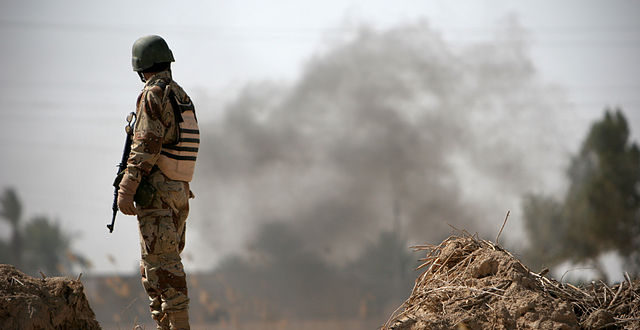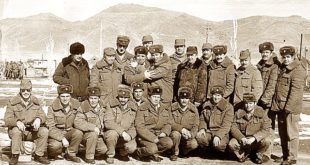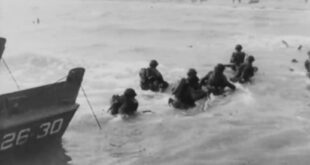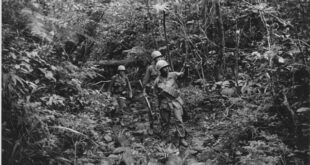by Sonner Kehrt, The War Horse
On a late spring day in 1945, a boyish-looking 17-year-old reported to the Naval Station Great Lakes, just north of Chicago. His name was James Ryals, but everyone called him by his middle name, Jerry. Jerry had been so eager to serve that he’d gotten permission from both his parents and his principal to leave high school early to join the Navy.
But just a few weeks after reporting in, Ryals found himself in the sick bay. The diagnosis was “pharyngitis”—a severe sore throat, fever, and congestion that kept him in the hospital for almost two weeks. That’s what his medical records say, but Ryals told his son Jay years later that he also remembered his skin was covered in red welts and blisters. And he remembered that he wasn’t alone in the sick bay. His entire company was there with him, suffering from the same symptoms.
Later that summer, when he was home on leave, he ended up back at a naval hospital with the same problems. Then, two years later, after he’d been discharged, he put on an old uniform from that summer, and the blisters reappeared. Other health problems followed: chronic bronchitis and low blood oxygen levels, chronic kidney disease. He lost his senses of smell and taste during basic training and never got them back. One of Jay Ryals’ earliest memories was tasting the milk the milkman delivered to tell his dad whether it was sour.
The day before Jerry Ryals was diagnosed with pharyngitis, his company lined up and walked into a gas chamber. They removed their gas masks and breathed deep. Then they went for a run. Almost right away, Ryals told Jay, men started dropping. Before long, he said, they were all in the hospital together.
During World War II, the government studied the effects of mustard gas and lewisite by testing them on as many as 60,000 American servicemen. The program wasn’t declassified until 1993, and veterans like Jerry Ryals spent their lives fighting to prove their recurring health problems were connected to the testing. Even after the military acknowledged the program, some veterans never received the benefits they deserved.
For decades, soldiers and sailors serving at home and abroad have been exposed to a wide variety of chemicals and toxins, from mustard gas to radioactive waste to contaminated drinking water. Often the hazards these toxins pose either aren’t known or aren’t disclosed. Proving a connection between health problems—which often appear many years later—and these exposures is difficult, and for decades, veterans have struggled to prove they encountered dangerous chemicals and to have their diagnoses recognized as service-connected.
Now, for the first time, Congress is considering comprehensive legislation that addresses toxic exposures in the military. If it passes, it will establish a new framework for how the military and the VA approach toxins and the veterans who have been exposed. Advocates see a watershed moment to redefine how we conceive of, and care for, the wounds of war—particularly the ones the body reveals only years later.
“This is a recurring pattern,” says Aleks Morosky, a government affairs specialist with Wounded Warrior Project. “Hopefully, maybe the next generation of veterans who are exposed—if they are—won’t necessarily be starting from square one.”
‘No One Had Ever Thought About Toxic Exposures’
In the winter of 2019, Andrew Myatt, a former Army officer, was hiking with his wife in Zion National Park when he got a phone call from his doctor. Myatt had recently had a routine physical, and the doctor was calling about some bloodwork.
“He said, ‘Hey, I just got your results. You either have bone or blood cancer. I don’t know which it is, but you need to get back,’” Myatt recalled. When he returned home to Washington, D.C., Myatt was diagnosed with acute lymphoblastic leukemia, an aggressive bone marrow cancer far more common in children. He started chemotherapy a week later, and he’s still going through it today.
At first, Myatt thought it was just bad luck. It wasn’t until his civilian doctor mentioned his military service and Veterans Affairs evaluated his history that he started to realize the breadth of toxins he had been exposed to: burn pits in the Middle East, depleted uranium from an old weapons system at Fort Knox. He’d cleared IEDs with chemical weapons attached in Iraq and dug up old mustard gas canisters in Germany.
“I had never even heard of the risk,” he said. “No one had ever thought about toxic exposures.”
The types of toxins service members encounter—and the ways in which they’re exposed—are myriad. By now, some exposures are household names. Agent Orange, for example, an herbicide used by the United States in the Vietnam War to clear vegetation, is well-known for its links to everything from leukemia to neurological disorders to birth defects. Gulf War illness, or wide-ranging symptoms among Gulf War veterans that can include muscle pain, headaches, fatigue, and memory loss, has been connected with neurotoxins like pesticides and the pills taken to protect against nerve agents during deployment.
But many other toxins, and their military history, are less well-known. Agent Orange was only one of 20 million gallons of different “rainbow herbicides” with similar chemical makeups used in Vietnam. Armored tanks often incorporate depleted uranium, a radioactive material, as part of their protective plating. Oil and gas wells caught fire during the Gulf War in 1991 and asbestos is common in older ships and buildings. At Karshi-Khanabad Air Base in Uzbekistan, a combination of radioactive uranium, jet fuel, and chemical weapons known as “black goo” oozed from the soil; veterans who served there after Sept. 11, 2001, have faced a rash of rare and aggressive cancers.
And then there are threats closer to home. For more than 30 years, from the 1950s through the 1980s, drinking water at Camp Lejeune was contaminated with benzene and industrial solvents. More recently, in 2018, a Pentagon report found at least 126 current bases with elevated levels of perfluorinated compounds in their water, which have been linked to cancers.
But because there’s often a long delay between the time someone is exposed and when an illness appears, making the connection between a toxin and a diagnosis can be tough.
“When there’s an event that happens on the spot, like a roadside bomb, there’s documentation of it in the record, there’s a clear line that the service member can draw,” Morosky says. “When it comes to toxic exposures, because of the latency period, it’s often difficult to draw that line.”
‘This Is Not a New Thing’
It’s hard to pin down exactly how many veterans are affected by toxic-exposure injuries and illnesses. There’s no central database for exposure, and many veterans and their doctors never make the connection between their health issues and their military service. But where data do exist, the numbers are sobering. Fifteen thousand soldiers were potentially exposed to the black goo at Karshi-Khanabad. More than 425,000 veterans are impacted by Gulf War syndrome, and around 2.7 million veterans were exposed to Agent Orange, according to data provided by Wounded Warrior Project and the Tragedy Assistance Program for Survivors (TAPS), an organization that works with families of fallen service members.
As veterans from the wars in Iraq and Afghanistan came home and began developing rare cancers and respiratory illnesses, they started raising awareness of a new hazard: burn pits. These open-air trenches, where soldiers burned for disposal everything from paint and plastics to human waste to unexploded ordnance, were common at operating bases in the Middle East.
“Basically everything would get thrown into the burn pit,” says Candace Wheeler, the director of policy at TAPS. “Many of our service men and women were downwind.”
In 2014, VA launched the Airborne Hazards and Open Burn Pit Registry, which allows veterans who may have been exposed to burn pits to opt into a database intended to inform VA research on possible health effects. So far, fewer than 300,000 people have signed up for the registry, according to the most recent VA data, though VA estimates that close to 3.5 million veterans are eligible to register. Veterans who sign up with the registry qualify for a VA medical exam to discuss their health concerns. Still, the government doesn’t acknowledge many of the specific health issues veterans organizations say may be connected with burn pits—though in early August, VA announced it would consider asthma, rhinitis, and sinusitis presumptively connected to exposure to particulate matter in Iraq, Afghanistan, and a number of other countries.
VA recognizes a handful of toxic exposures as having “presumptive service connection”—essentially, that means that if a person served in an area with a known toxic hazard and receives a particular diagnosis, VA will assume it was caused by exposure to the toxin and grant benefits to eligible veterans who file claims. The government has established presumptive connections for mustard gas and lewisite testing during World War II, Gulf War illness, certain radiation exposures, contaminated water at Camp Lejeune, and Agent Orange. But those connections were hard-won and often decades in the making.
“The situation that post-9/11 vets are in right now is the same situation that Vietnam veterans were in with Agent Orange for a long time,” Morosky says.
By the late 1970s, just a few years after the end of the Vietnam war, veterans were demanding that the government recognize a connection between cancer diagnoses and birth defects, and service in southeast Asia. However, it took nearly 15 years, until 1991, for Congress to pass the Agent Orange Act, which established a presumptive connection between soldiers who “set foot” in Vietnam and a number of cancers and other diseases.
But tens of thousands of others were exposed to the herbicide either while at sea in the waters off Vietnam or while serving in theater in other countries, like Cambodia and Laos. It wasn’t until 2019 that a new law finally extended benefits to as many as 90,000 “blue water Navy” veterans—and there still is no presumptive connection for veterans who served in nearby countries where Agent Orange was also used.
Even after a presumptive service connection is established, many veterans never get the benefits they’re owed. Just because a connection exists, it doesn’t mean someone is automatically extended benefits. Individuals still need to file a claim, which can be a time-consuming and confusing process. And because lists of connected conditions expand as more time passes and more research comes out, it can be tough to keep on top of which diagnoses “count.” Just this past January—a half-century after the end of the Vietnam War—Congress added three more diagnoses to Agent Orange’s list of connected conditions: bladder cancer, hypothyroidism, and Parkinson’s-like symptoms.
“It’s so frustrating because we already did this with Agent Orange,” says Coleen Bowman, a senior advisor at TAPS whose husband died of a rare bile duct cancer after multiple deployments to Iraq. “It goes back to World War II. This is not a new thing. And so knowing that, why aren’t there better screening measures in place?”
‘Both Bills Look to the Future’
In 2019, TAPS, along with Wounded Warrior Project and nearly 30 other veteran and environmental organizations, came together to form the Toxic Exposures in the American Military—or TEAM—Coalition. The goal was to coordinate efforts to advocate for greater recognition of toxic exposures and better services for veterans affected by the issue—not just today, but in the future as well, Morosky says.
Advocacy and growing public awareness around toxic injuries led to multiple bills in the last few years addressing components of specific exposures, among them black goo at Karshi-Khanabad, radiological materials at a former nuclear testing site on a Pacific Ocean atoll, and disparate bills addressing burn pits and Agent Orange.
“They’re all doing different things,” Morosky says. “What we did is … put them together, complete the puzzle, and come up with some omnibus legislation that pulls all the important provisions.”
The resulting bills were introduced earlier [last] summer. The House version of the omnibus bill is called the Honoring our PACT (Promise to Address Comprehensive Toxics) Act of 2021. The Senate version is known as the COST of War Act of 2021—COST stands for comprehensive and overdue support for troops.
While there are slight differences between the bills, both lay out an extensive plan for understanding and addressing toxic exposure. Legislation based on the bills as they’re written would concede exposure to burn pits and other airborne hazards, acknowledging that any veteran who served in Iraq or Afghanistan was exposed to these hazards. It would also create a presumption of service connection between burn pits and 23 different cancers and respiratory illnesses.
But the bills don’t only address burn pits. Legislation would ensure that any veteran who participates in what’s called a “toxic exposure risk activity” gets automatic access to VA healthcare. It would also establish an independent Toxic Exposure Review Commission to help identify possible toxic exposures and recommend further scientific and medical study; VA would be required to respond publicly within 60 days to scientific recommendations to establish new presumptions of service connection.
Critically, the bills also shift much of the burden to prove toxic exposure away from individual veterans to VA. VA would be required to examine a veteran’s medical record and Individual Longitudinal Exposure Record, or ILER, a tool that creates a record of personal service history and helps correlate it with any known chemical exposures, either those already in existence or any that come to light down the line.
“Both bills look to the future,” Morosky says. “These are the things that toxic-exposed veterans of any generation need.”
‘He Filed His Claim in 1947’
When Jay Ryals was a child, he didn’t know why he had to taste the milk the milkman brought. He didn’t know the breathing problems that plagued his dad over the years would later be listed by VA as presumptive conditions connected to mustard gas testing. His father filed his first claim with VA—for pharyngitis—not long after he got out of the Navy. The VA rating sheet, which rated him at 0%, noted widespread skin disturbances but stated they weren’t from his service.
Over the years, Jay Ryals and his mother wrote letters to VA and to lawyers. When Jerry had a stroke, Jay sold his house to be nearby. Then, two years before Jerry Ryals died, VA gave him a 100% rating.
“He filed his first claim in 1947,” he says.
The difficulties that follow toxic exposures aren’t borne only by veterans themselves, says TAPS’ Wheeler. Loved ones become caregivers. The struggle to prove—to VA or just to the neighbors—that an illness or an injury was caused by military service can be all-consuming. Each time a new generation of service members encounters a new toxin, the cycle repeats.
“We don’t know what will be coming down the line,” Wheeler says. “We should be doing everything to be proactive. And that’s understanding that the cost of war comes home. The battlefield isn’t a place anymore.”
This War Horse feature was reported by Sonner Kehrt, edited by Kelly Kennedy, fact-checked by Ben Kalin, and copy-edited by Mitchell Hansen-Dewar.
Editors Note: This article first appeared on The War Horse, an award-winning nonprofit news organization educating the public on military service. Subscribe to their newsletter
 Soldier of Fortune Magazine The Journal of Professional Adventurers
Soldier of Fortune Magazine The Journal of Professional Adventurers






